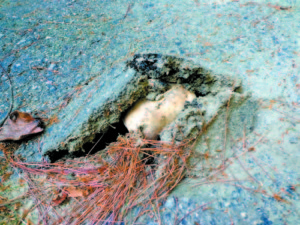Earth Notes: The Mighty Mushroom
By Sally Chappell
I intended to write about the evils of nuclear weapons, but one day in September, a mushroom started sprouting in our asphalt driveway. Over the course of the next few days, I snapped pictures of it and shared my amazement with some friends near and far. One neighbor astutely remarked that it was either a mighty mushroom or a poor grade of asphalt. I replied that I thought it was both. Our driveway was done over 30 years ago and only seal coated once. It is showing its age with tire depressions and grass taking over in one large patch, probably due to the gravel base not being deep enough. I was truly awed by the power of the mighty mushroom pushing up a full four inches of a portion of the asphalt that was still in good condition.
The mushroom diverted my attention to driveway options. What could we do about our driveway that obviously needs replacement? Are there any environmentally friendly ways to pave a driveway? An Internet search yielded some answers. Three criteria affect a driveway’s “green-ness†— permeability, heat island effect, and materials.
Paving that is permeable can absorb rain rather than divert it to another location. Asphalt and concrete surfaces, being impermeable, do not meet this criterion. Small areas are probably not a problem, especially in rural areas like ours, but the amount of asphalt and concrete affects the amount of flooding that occurs in cities and towns.
Then there is the heat island effect. It’s hard to surpass the black matte beauty of new asphalt or its ease of maintenance, but its blackness absorbs the sun’s rays and radiates heat. Again, this is not much of a problem in rural areas where trees abound. Cities on the other hand, with abundant and ever-expanding amounts of paving, are noticeably hotter in the summer than rural areas, surely a consideration as the earth heats up and climate mayhem worsens.
While asphalt has rendered mud season irrelevant, it does not make the cut for “green-ness†on the materials front either. As one blogger wrote, “can something that smells that bad really be green?†It is a petroleum product and therefore a no-no on environmental friendliness.
What are some better choices for driveways? Permeable concrete, ceramic pavers or ones made of recycled plastic, fiberglass grating filled with permeable substances such as sand, grass with a structural lattice (there is a product called Grasspave), gravel and sand, crushed stone, and crushed seashells are ones I was able to find. Some options like permeable concrete are difficult to find because it requires certification of the installers, a problem in sparsely populated Maine.
Our deteriorating driveway will have to remain in its present state for the foreseeable future. It’s OK with me if more mushrooms pierce the asphalt as long as mushroom clouds do not pierce our atmosphere.
Dr. Robert J. Lifton, an American psychiatrist and author of over 20 books, has most recently written Climate Swerve: Reflections on Mind, Hope, and Survival. In an interview with Amy Goodman and Nermeen Shaikh on Democracy Now, Lifton addresses the apocalyptic twins of nuclear and climate threats and those people who profess nuclearism, “an embrace of the weapons to do everything that they can’t do and to utilize them instead of what should be utilized in the way of peacemaking.†Likewise, to “just go on using fossil fuels, we will do ourselves in as a civilization, pretty much by the end of this century.†He terms such paths, “malignant normality.â€
There are efforts afoot to ban nuclear weapons. This past July, 122 members of the United Nations crafted the Treaty on the Prohibition of Nuclear Weapons. Presently, 53 nations have signed the treaty and three nations have ratified it. The treaty will become international law when 50 nations ratify it in the same way that cluster munitions, landmines, and chemical and biological weapons have been outlawed. For their role in this historic agreement, the 2017 Nobel Peace Prize was awarded to the International Campaign to Abolish Nuclear Weapons (ICAN). On the national front, we have a bill in the House of Representatives, HR 3853, the Nuclear Weapons Abolition and Economic and Energy Conversion Act of 2017. There is the admirable work of the Nuclear Age Peace Foundation particularly their work on peace literacy. Let’s envision the achievement of a world with a stabilized climate and without nuclear weapons. Mushrooms…yes; mushroom clouds…never!
Sally Chappell
Bridgton


